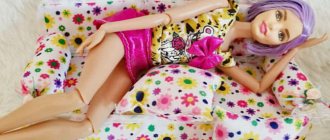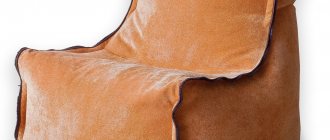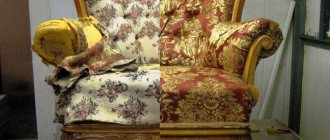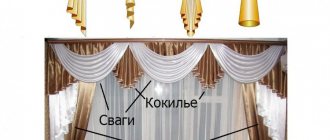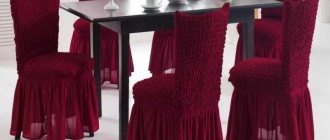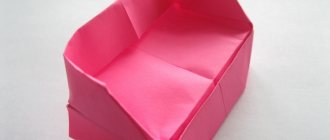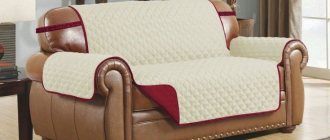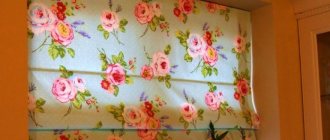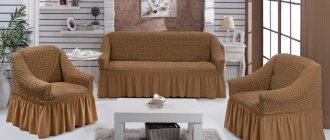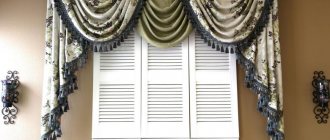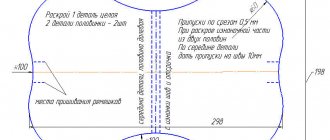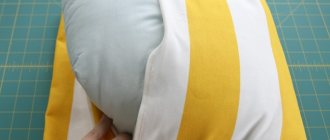Many people face the problem of an old sofa and its restoration. Buying a new sofa is sometimes beyond your means. And if you want to change the upholstery on it, that is, restore it in a workshop, this will also bring large costs. We have a way out of this situation - buy a beautiful blanket for a sofa or chair, which you can make with your own hands
Varieties
Every day, the developers of blankets, bedspreads, and covers do not stop developing their works, continuing to fantasize and use new tricks. As a result, this led to a wide variety of styles, from simple to multifunctional, for all models of sofas and armchairs.
Features of covers for sofas and armchairs, their variety
Types of capes:
- Universal . The material is shaped like a rectangular towel, which is simply laid over the sofa. It suits both sofas and armchairs.
- Fragmentary . Rectangular material secured with Velcro or ties.
- With additional functionality. Includes small pockets for the remote control and other household items, this is important for small rooms.
- Euro cover or tension cape . It completely covers upholstered furniture, repeating its shape and bend, smoothing out all the unevenness on the surface.
- Plaid with different effects. The most favorite to use are housewives who like to wrap themselves in a blanket that retains heat, which will not only warm, but also protect the sofa.
A way to give your sofa a new life
Methods for making a blanket
There are several techniques and methods for making a knitted blanket, which can be done in different ways:
- sew from squares cut from old knitwear using the patchwork technique;
- a blanket knitted by hand without knitting needles from super thick yarn;
- knit with knitting needles from shaggy yarn to imitate a fur blanket;
- made from fluffy pompoms on a knitted mesh (no knitting experience);
- crochet from leftover yarn using the granny square technique;
- assemble a large fabric from single knitted motifs of the same format.
As you can see, there are many interesting ways to make a homemade blanket. In this case you can vary:
- product dimensions;
- knitting thickness;
- color scheme;
- general design concept.
Important! A standard size blanket is 1.5x2m, a children's blanket is half the size, a warm chair cover is 1.3x1.7m.
As you can see, large-scale knitted fabric can be used in different ways in the interior:
- like a hand-knitted baby blanket;
- in the form of a homemade rug in a children's room;
- instead of a light blanket in the warm season;
- as a chair cover that you can wrap yourself in on winter days while watching TV series;
- hand-knitted plush blankets as bedspreads;
- as a spectacular accent in the design of a living room.
Someone loves the process of knitting, then you can take on painstaking work that requires several months to complete the idea you like.
Others are result-oriented and lack patience - it is recommended to take on “high-speed” techniques. Such items are knitted from thick yarn, using knitting needles or a hook with a large number - from No. 4 and above.
DIY bedspread with hard armrests
Let's look at the three main common problem areas associated with sofas. For starters, these are the armrests . Usually, there are stains from tea, coffee, crumbs, and abrasions. This is also a favorite place for pets, because the corners can be wiped and ripped apart. The second problem area is the traditional place where people sit. The pillows collapse under the weight of the owners.
Let's move on to designer, cheap restoration. The first thing we'll start with is the armrests.
Armrest
It would seem that the most difficult thing to make is something that cannot be sewn. But, on the contrary, this work is much faster and easier, thanks to assistants that have long been available in construction stores. These include corners and screws. We propose to create not just a corner cover, but also armrest tables. Thanks to the plywood joints, we can create a solid support not only for hands, but also for cups and plates. You don’t even have to wash such a cover; all you need to do is wipe it with a napkin to remove dust, crumbs, and dirt.
In brown
The first step is to measure the width, height, and other data. We draw and describe the measurements in detail on paper. At a hardware store, you can ask the seller to cut you the required size sheets of plywood that you will need to paint. In any case, the width of the plywood should be 8 mm.
Please note that the width of the plywood can take up several millimeters or even centimeters from the length of your plywood, so leave a few extra centimeters so that the cover fits easily. We fasten the plywood boards together from the inside of the right angle using a metal corner and screws, creating the shape of your armrests.
Use sandpaper to sand down any imperfections on the plywood sheets.
Now you can paint the shape of the plywood cover with paint in the color of your design. We recommend using acrylic paint; it dries faster and is virtually odorless, so you can do this activity even at home. It is better to choose dark colors for the armrests; they create more contrast with other colors. You can also decorate them with original patterns, rhinestones or fabric, the choice is very large. Once the paint has dried, you can try on the covers for the armrests . If you are completely satisfied with them, the work can be considered completed.
In Provencal style
The next stage is sitting.
seat
It usually consists of two parts:
- the main part is for soft places;
- lower detail, hides the bottom panel of the sofa.
The seat and back will require 150-170 cm of fabric. To choose the size of the desired piece of fabric, you need to measure the sofa as a whole and in parts to choose the size of the parts. We measure the width and depth of the seat on the inside, and measure out the required pieces of fabric. We need width allowances of 7 cm. 1 cm on each side - these are seam allowances, 5 cm for soft places that may rise a little during use.
Easy to remove and clean
We use the material with padding polyester.
You can make compartments with different thicknesses. It all depends on imagination and taste, many narrow little ones, for children’s butts, or one big one. If the seat is divided into parts, then the parts should be symmetrical. We make marks on the fabric along the front side, so it is advisable to use easily erasable chalk.
Buy useful materials. You can use fabrics for curtains, they are dense, usually sewn with a width of at least 2.70, or even 3 meters. A good choice for sewing a seat. Next, choose the decorations. For example, you can use tucks, with them graceful piping will be visible.
Make a fold in the fabric . You need to determine how often the stripes will occur. You can do it with a small distance from each other or with a large one, rely on your choice.
Ideal protection for your furniture
Advice When choosing fabric, it is advisable to choose not very bright and catchy shades, so that the cape does not turn out tasteless. If there are two combinations of shades, there is no need to add small decorative elements such as polka dots. It will look messy.
We use, for example, 3 folds. In this case, divide the fabric into 4 parts.
They come in equal and different sizes.
In general, there is no limit to imagination, so use any options. In order to place strips inside the fabric, it must be at least a couple of millimeters wider than the depth of our tuck. We turn a cut strip of a different shade, which will differ from the main fabric, into a small tuck, connecting the top strips. We fix it with a pin so that it does not diverge. In order for it to form, you need to iron it with an iron. We repeat the steps with each part.
After ironing the elements, you can remove the pins. We tuck the strip into the resulting fold, then secure it with a pin again. Try to keep the strip neat and evenly peeking out from all sides. Then it will look very professional.
When choosing fabric, focus on not very bright and catchy shades
Then, we make a line on top in order to secure it all.
You can do everything using a sewing machine or by hand. After we have done this, we still have edges around the perimeter that are not processed, they need to be hidden. When purchasing fabric for pintuck strips, take into account centimeters for reserve. We take the second piece of fabric with the same color as the main fabric, with the same size, cover it, fold the first piece of fabric with stitched tucks. In fact, you should end up with a pillowcase of sorts.
It needs to be stitched on three sides so that one side can be turned out. We definitely do this on the side where we have three highlighted elements and where the backrest is adjacent to the seat. We stitched the fabric, turn it inside out. We use pins to mark three vertical lines and one horizontal that will divide the seat into three parts. We flash them. Thus, we form three pockets, which we will directly fill with padding polyester.
Easy to make yourself
You can use the materials that are in the house, if there are some unnecessary pillows that match our cover in size, then instead of padding polyester you can use these pillows, they also add volume.
Sintepon comes in different thicknesses. It is better to take a medium thickness - this is 3 cm. It all depends on how lush the sofa we want to get.
Let's move on to processing the edges. We need to tuck them inside and sew them again. Everything remains inside, the seams are all hidden. These seams must be taken into account when determining the size of a piece of fabric; no less than 1 cm on each side will be left on the seam. We also make a gap for the padding polyester, since in some places it rises.
Tip To secure the cover, we will use Velcro. To prevent the pillow from moving, it is better to secure it. You can do this across the entire width of the sofa, or in several places, as you wish. We will use Velcro so that we can wash this cover in the future.
Option with ties
We fix the adhesive material with a needle and thread. You can use a glue gun on the sofa. There is an option to sew, but it takes a little longer and is not always convenient to sew on the sofa. But with the help of a glue gun, the tape holds perfectly. Thus, on the reverse side, using one Velcro, the edge of the pillow is secured. We can do this in small parts or, on the contrary, in a whole strip.
There's just one small thing left to do - the back.
Back
Using the same technique, you need to make a rectangle of fabric that closes on both sides just like a pillowcase. Create your own highlight - puffs . This fastening together of several pieces of material, which are folded into folds and form a beautiful relief, is called puffs.
You can use a regular blanket
Now this technique is at the peak of popularity. Many Italian designers use these techniques to create their sofa collections. Similar sofas cost from 6,000 euros.
That is, this is an expensive technique. We will make the simplest of puff techniques - neat little tucks, in a checkerboard pattern, which look very beautiful.
After we have constructed the puffs, as in the version with a seat, we apply the second part face to face, stitch it on all sides, turn it inside out and fasten with Velcro. It is advisable to sculpt it on the back from all sides. Firstly, the owners can rub against the back, secondly, if we tighten the seat well, then all our folds will open slightly and they will be noticeable.
This is the element that needs to be shown; it is beautiful, effective, and looks very nice.
Classic style
The last element is pillows . Decorate your sofa or chair with such a unique decor so that the plywood armrests and the shades you choose and new pillowcases look harmonious. It will look even better if these pillows are the same shade that you used for the tucks of the bottom of the pillows and for the puffs.
This option for designer restoration of your sofa will cost up to 1000 rubles. That is, such restoration of upholstered furniture consists of soft cushions for the seat, backrest and armrests, which will serve as a mini-table.
The variety of capes depends not only on the palette of shades, but also on the type of material.
In purple
Sofa ottoman - fabric consumption for such a sofa
Sofa ottoman. Undoubtedly one of the most comfortable and functional sofas for a small apartment. It is convenient for one person to sleep on it either folded or unfolded - the sleeping place can reach the size of a full double bed 190x200cm. A spacious laundry niche and a mini-bar are not all the advantages of this model. If you have such a sofa at home, you are unlikely to want another. Over the course of using it, we have become accustomed to its comfort and functionality, until it’s time to restore it. Give your old sofa new, stylish upholstery.
So how much fabric will you need for such a sofa?!
For an example of calculation, let’s take the largest model with a sleeping area of 190x200cm. The layout on a 140cm wide fabric for an ottoman will look like this:
From the figure we see that such an ottoman requires 9.6 linear meters of fabric. If you have a smaller bed, you can proportionally reduce 2 seats, a backrest and a linen drawer to the required size.
Example: you have an ottoman sofa with a sleeping area 160 cm wide by 200 cm long when unfolded. For your sofa you need 30cm less fabric in all parts except the sides and pillows - they remain the same size.
What we will get:
- two sofa seats minus 30cm each (the fabric is 60cm less)
- the back of the sofa and the linen drawer will be reduced by 30cm proportionally, the uppermost cut measuring 60x50cm for the pillows will move down and save some fabric.
In total, we do the calculations and see that for an ottoman with a bed width of 160 cm, 8.6 linear meters of fabric will be needed, which is 1 m less.
Capes without armrests
Covers for such sofas are usually stretch covers. They cover the entire sofa. These include Euro covers. They are made of bamboo, hypoallergenic and protect furniture not only from the clumsy hands of adults and children, but also from pets whose claws get caught in threads of fabric.
Also, such covers can have ties that are sewn on the lower corners of the sofa. Typically, such sofas are distinguished by a dense frilly base.
Sofa decks made of carpet also belong to these types of covers, in the form of a track, which covers the seat and back, the armrests remain open.
Bright option for home
Bright carpets can be fringed.
Covers without armrests can look simple and attract only by the material or color. If you value unusual accessories, we suggest you pay attention to covers with a skirt. Their feature is a long, light frill gathered into an accordion. More suitable for tall sofas.
Any type of sofa cover without armrests can be decorated with a variety of pillows with frills or original shapes in the form of emoticons, symbols and cartoon characters. The main thing is to combine it correctly with the color scheme and interior.
Such cases are usually decorated with simple symbolic phrases or company logos. Minimalism is perfect for design.
Bright striped material
Frill on the bedspread
A frill is another idea for decorating a bedspread on a sofa (photo below).
The order of work for its implementation will be as follows.
- Take fabric of the required width. You can use either a new piece or scraps left over from sewing the bedspread.
- Hem the entire fabric on one side length to prevent fraying.
- Fold the piece into a light accordion shape and start stitching it.
At the same time, if you want the frill to be visible, then place it on top, having first tucked its edge inward. You can do either one or two lines. If you want to hide the frill, then attach it to the bedspread from the back side.
Quilted bedspreads
The sophisticated color scheme will lift your spirits and please the eye. The advantages include the fact that they have a sealant inserted between the main material and the lining fabric, most often a padding polyester.
Thanks to this combination of fabrics, the bedspreads are lush and soft, hiding the folds on the sofa. There are these types of stitches:
- thread stitching - expensive models;
- thermal stitch.
Thermal stitching is used only for bedspreads made of artificial fabrics. It involves bonding the layers of a bedspread using a special device that precisely melts synthetic fibers.
In unison with the rug
It is voluminous and takes up a lot of storage space. Therefore, it is difficult to wash. Any bedspread must be washed at least 2 times a year. Or clean it from dust and be sure to ventilate it.
Selection of models by style
The easiest way is to choose a simple monochromatic quilted bedspread; the only difficulty will be the selection of harmonious shades.
Bedspreads with patterns require special attention. The difficulty lies in choosing styles. For example, the Borocco and Rococo style is characterized by bedspreads made of satin and silk fabrics, decorated with frills, ruffles and lace.
Bedspreads decorated with small monotonous flowers are typical of Provence. Monochromatic colors, straight lines or checkered patterns are preferable to Classicism. The patchwork technique, as a rule, harmoniously combines with the country style: highlighted squares with delicate roses and a diluted picture with bed tones will create charm and comfort.
Cozy option for reading a book
3D flower designs will fit perfectly in the Art Nouveau style, with delicate frills and an animal skin rug. Modern motifs with metallic shades, of course, are assigned to High-Tech, but it is possible that it will not suit Loft; for this you need to add several symmetrical lines.
An oversized bedspread on your upholstered furniture will look untidy, dirty and give the effect of disorder; the bedspread should correspond to 110 by 140 cm. For a double bed, the following standards have been noted: 200 by 220 cm.
European beds are famous for their maximum sizes, so a bedspread for a standard double bed will be small, so choose sizes from 220 by 250 cm to 230 by 250 cm.
In the style of minimalism
Preparing to knit a blanket
With the correct organization of the process, even an inexperienced craftswoman can complete such work. It is enough to clearly define the following details:
- decide on color;
- choose what shape your product will be;
- decide what yarn to knit the item from;
- decide what to knit: knitting or crocheting.
Once you have decided on these points, you can purchase yarn and start knitting.
Choice of colors
Handicrafts should be in harmony with the furniture and decoration of the room, and also correspond to the style direction.
- if the windows are located on the north side, then using a bright red or orange shade will visually add warmth to the room;
- if the room is filled with sunlight, choosing a cool-toned blanket will help give it a little coolness;
- Another great move is playing in contrast.
Deciding on the shape of the blanket
Typically, a sofa bedspread is knitted according to the shape of the furniture: a rectangle for a classic one, a circle or an oval, of four parts connected diagonally for a corner sofa. This criterion also means which option you prefer to use: a lace, elegant cape or a thick, warm blanket.
The first option is used to give the room more beauty and elegance, and has a completely decorative function. The second allows you to create an atmosphere of the warmth of home in the room. Not only does it serve as high-quality protection for furniture, but it will also help keep you warm if used as a blanket. There is also a difference in size: the blanket can completely envelop the sofa or cover it only partially.
Material selection
This criterion will completely depend on what purpose the product will serve (only decorative or combining decor and comfort). Another important indicator will be the price of the material. Each needlewoman chooses the yarn she would like to work with. But there are several preferable options:
- Silk. Great for beautiful, lace capes. Products made from it add a touch of luxury to the interior. The only downside is the rather high cost.
- Viscose. This is an analogue of artificial silk, but an order of magnitude cheaper.
- Cotton. The most widely used material for lightweight capes. Easy to wash. There are many pleasant colors in the color palette of the yarn.
- Wool. Great for thick blankets that you can wrap yourself in to stay warm.
- Acrylic. Synthetic yarn, ideal for various variations of this item. Keeps its shape and color for a long time. It also has a relatively affordable price.
Selecting the right tools
The choice of tool will depend on the thickness of the yarn you will knit the item with.
Typically, yarn manufacturers indicate the number of the working tool on the packaging.
It is also important to pay attention to the material of the knitting needles or hook:
- Plastic ones are suitable for knitting light yarn. They may become deformed in the process.
- Wooden ones, like plastic ones, are subject to deformation and can break under strong pressure.
- Metal ones are the most widely used. They are very convenient, but be sure to wipe the surface with a soft cloth before use. This will remove a small deposit from the metal, which makes it difficult for the loops to move through the process and can stain the threads.
Fur bedspreads
Made from faux fur with soft pile. They are fluffy and pleasant to the touch. However, they attract dust. The fibers themselves are sewn into the structure of the fabric, so they will neither fall out nor fray. Due to the long pile, air accumulates in the fibers, helping to preserve the natural warmth of your body.
Depending on the lighting, darkness, and angle of incidence of light, fibers can refract light and change it slightly. For such capes, it is better to use dry cleaning services. Capes are often painted leopard, tiger and other colors.
Fur bedspreads in delicate or contrasting shades will be luxuriously suited to a Glamor style interior.
Such capes add coziness and warmth to the room; the soft and fluffy structure of the fabric tempts you to rest and relax.
When everything is in tune
Material selection
There are a number of requirements for the fabric for a cover. First of all, it is strength, wear resistance, and ease of maintenance.
The following items answer these requests:
- jacquard;
- flock;
- shinil;
- artificial and natural leather;
- microfiber;
- artificial and natural fur.
Patterns of crocheted baby blankets from our readers
Our needlewomen crochet a blanket for children, look how many beautiful patterns there are!
Children's crocheted blanket Little Fox. Work by Vera Koval
The “Little Fox” blanket is crocheted No. 2 using the “corner to corner” technique from Vita Baby yarn 100% acrylic, green, orange and white, black - 100% wool. Easily washable in warm water, soft, takes up little space. The drawing looks equally good on both sides, size 78x98 centimeters.
“Video How to change the color of the thread when crocheting using the C2C technique (from corner to corner, diagonally)”
The video should load here, please wait or refresh the page.
Children's openwork crocheted blanket
To knit this blanket, a hook No. 1.5-2.5 and cotton threads are suitable. Author of the blanket: Violavia. Blanket size: 98 by 98cm, yarn=YarnArt Gold, 100g=400m, 92% acrylic, 8% metallic polyester. It took: about 350-380g. My hook has no number (old, favorite)
Children's blanket crocheted by Elvira Vyazalova
Hello, my dear friends. Not long ago I finished working on this wonderful baby blanket. Blanket size 160×90. I knitted it in 15 days. It took me 20 skeins of pekhorka yarn, a children's novelty. The blanket consists of
How to crochet a baby blanket
Peach colored plaid. Material - 500 gr. acrylic thread. Plaid description: cast on 214 chain stitches + 3 chain stitches. for lifting and knit with the main pattern according to pattern 1, 87 cm. Assembly - tie the blanket with the 1st row of st.b.n.
Children's crocheted blanket from Inna Palchun
The children's blanket is crocheted No. 1.75 from Semenovskaya yarn “Tenderness”. Size 95*95 cm. The yarn composition includes cotton and viscose. Yarn consumption 700-800 g. The blanket turned out to be soft and gentle to the touch. Viscose gives the product a rich shine. Scheme
Children's blanket with crocheted flowers from Bagal Ekaterina
Hello, I have been knitting recently, but I already have some work to do. I wanted to share one of them. I knitted a baby blanket. Size 75x70 cm. For work I used New kid's Pekhorka threads (100% high-volume acrylic) 5 skeins of 50 g each,
White crocheted baby blanket
A blanket for discharge in a universal white color is perfect for both a boy and a girl. The size of the blanket shown in the photo is approximately 110 * 110 cm. Thanks to the yarn (Velor from Nazar), the blanket turned out to be very soft and delicate. Used up
Children's crocheted blanket Angel Wings
Blanket for discharge “Angel Wings”. Knitted from soft silky yarn “Maigik” (100% microfiber; 50 gr./152 m) with a 3.5 crochet hook. Decorated with a flower - a brooch, knitted using the Irish lace technique, in the middle of the flower there is a rhinestone in the form of a diamond. A blanket will do
Children's crocheted blanket - Tatiana's work
Mint blanket knitted from Children's cotton Pekhorka. Yarn consumption: six skeins, hook number 2. Blanket size 90*90. I’m sharing a diagram that I found on the Internet. The diagram is taken from here
Children's crocheted blanket - the work of Marina Stoyakina
A baby blanket is an incredibly beautiful and practical thing, as it is used from the birth of the baby until at least 3 years of age! In classic brown-beige color. Knitted from 100% cotton “Begonia” with crochet number 2. Thread consumption for size 1x1m is approximately
How to knit an openwork baby blanket
Hello dear needlewomen! I would like to show you a baby blanket that I knitted for discharge from the maternity hospital. Size 105 x 105, yarn taken “Gazzal - Baby Cotton” (60% cotton, 40% acrylic, length 50g 225m). The yarn is very soft
We crochet a beautiful baby blanket
Children's blanket (size: 100cm x 100cm) is made of Kamtex NADEZhDA yarn (30% wool; 70% acrylic), 220m - 100g, crochet number 4.5. It took 4.5 skeins. Knit according to the pattern to the desired size. The blanket is tied with lush columns. Knit for a brooch
Crochet openwork blanket for stroller
I knitted the blanket more than 2 years ago, so the hook number and consumption have already been forgotten. The hook is supposedly 1.5, the yarn is Turkish mercerized cotton 565 m per 100 g. Size ~75x75 cm. Used in the summer in a stroller for beauty. Plaid
Children's blanket for a special occasion - baptism, discharge from the maternity hospital. Knitted from 100% German mercerized cotton “BEGONIA”. A satin ribbon is used as decoration, secured at the corners of the product with gold buckles and rhinestones. This ensures secure fastening and
Decoding the circuit for beginners
In order to easily read patterns for chair covers, you should know how different types of loops are indicated on them. You can find them on specialized resources for needlewomen. Graphic images usually use the symbols presented in the table.
| Designation | Decoding |
| Dot or small circle | Air loop |
| Vertical stripe | Single crochet |
| Vertical stripe with crossbar | Double crochet |
| Vertical stripe with two (three) transverse lines | Double crochet stitch |
| Small bracket with ends down | Connecting post |
| Arch with a number in the middle | A chain of air loops (the number of loops corresponds to the number under the arch) |
| Circle with a number inside | A closed ring of air loops (the number of loops corresponds to the number in the circle) |
| Check mark | Two single crochets knitted from one loop |
| A checkmark with one (two, three) crossbars on each side | Two double crochets (two, three), knitted from one loop |
| Dot or small circle | Connecting post |
| Vertical stripe | A chain of air loops (the number of loops corresponds to the number under the arch) |
| Vertical stripe with crossbar | A closed ring of air loops (the number of loops corresponds to the number in the circle) |
| Vertical stripe with two (three) transverse lines | Two single crochets knitted from one loop |
| Small bracket with ends down | Two double crochets (two, three), knitted from one loop |
| Arch with a number in the middle | Connecting post |
| Circle with a number inside | A chain of air loops (the number of loops corresponds to the number under the arch) |
| Check mark | A closed ring of air loops (the number of loops corresponds to the number in the circle) |
| A checkmark with one (two, three) crossbars on each side | Two single crochets knitted from one loop |
| Dot or small circle | Two double crochets (two, three), knitted from one loop |
When it comes to deciphering circuits, you should know the most important rules. If the patterns are knitted from the center to the edges, in straight and reverse rows, they need to be read from bottom to top. Odd rows should be deciphered from left to right, even rows – vice versa.
A handmade cape will definitely give your home comfort and a special atmosphere. It will protect furniture from dirt, animal claws, and help update the interior. Knitting is not particularly difficult even for a woman who has never picked up a crochet hook or knitting needles before.
Conventions for crochet patterns
Functional Features
When making a textile item, you need to immediately determine what and why it is needed. The thing performs several functions at once, which are of great importance in their field:
- The sofa upholstery is protected from mechanical and other damage.
- Does not allow dirt to penetrate into factory upholstery.
- Decorative. A handmade product will be unique and add an atmosphere of comfort and individuality.
- An additional feature of the model may be the presence of a blanket.
Functionality
You can come up with a few more elements that will make the thing more original. You can sew small pockets to the sides of the cover. Here you can store the TV remote control, magazine, glasses.
How to crochet blankets
A large DIY blanket is a labor-intensive and time-consuming process. You can master a simple but beautiful pattern, make a solid canvas that will gradually “grow” as you work on winter evenings.
Some needlewomen prefer knitting with squares. For beginners, it is better to start making simple motifs, such as a “granny square” or something similar using a simple pattern.
The finished fragments can be sewn or interlocked during knitting - one square is joined to another element at the corners or protruding parts of the pattern.
Fragments or squares can be supplemented with cute knitted animals, butterflies or berries - you get an original children's blanket.
It doesn’t have to be squares, use any fragment you like - circles, triangles, 6-gons or rhombuses
It is important that they are knitted from yarn of the same thickness, then the fabric will be smooth and neat
Design and shape
To make a cut, you need to decide on the model and shape. There are several basic options. The shape of the parts can be angular or rounded. As for the model, it is important to take into account the type of sofa itself - corner, round, long, square.
Shape and design
There may be fasteners in the form of ties, elastic bands, buttons, or zippers. Additionally, you can sew on ruffles, frills, inserts and frills.
